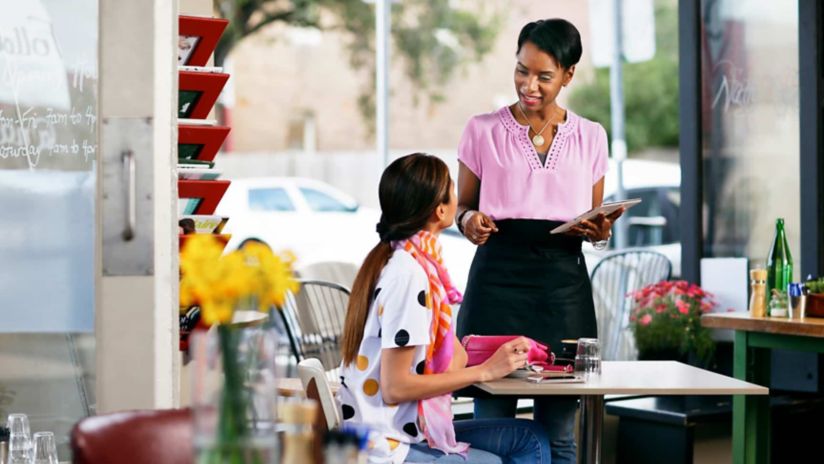6 ways to thrive in the hospitality industry

How the hospitality industry is changing
If you work in the hospitality sector, you're likely aware of the challenges in your industry. From difficulties with staff retention to changing customer expectations, there's a lot to navigate. So, knowing how to adapt and embrace new tech is more important than ever.
Here, industry expert Ashley Cooke shares six tips to prepare your business for most situations in the shifting landscape. As Director at Future Food, an agency at the forefront of food and hospitality consulting, Ashley knows more than a thing or two about how to put your best foot forward in challenging times.
1. Look after your employees to help improve staff retention
Supporting your employees’ growth helps staff retention. This, in turn, has positive flow-on effects for your business. Happy team members help you strive for high standards and deliver great customer service.
“Staff are seeking job satisfaction and an employer who cares about them,” Ashley says, adding that there are many ways to improve employee satisfaction.
Ways to keep your workers happy in hospitality
- Offer perks where possible, such as staff meals, free parking and discounts for employees’ family and friends.
- Provide training to help your team to help upskill. This may include giving your employees the chance to work with your suppliers and producers. Hands-on learning can empower your people with knowledge they can pass on to your customers.
- Help your staff cross-skill to improve daily operations during staff shortages. This allows you to train what Ashley refers to as float staff, individuals who can work across different areas of your business.
- Foster a safe work culture and, in Ashley’s own words, “openly discuss what work practices are causing stress and seek to reduce the impact of these.”
Why is upskilling staff in the hospitality industry so important?
Hospitality can be a high-pressure environment, so the more you can train your people and support their mental health, the more likely they are to stay. “A multi-skilled workforce is [also] a great asset for workforce planning and labour management,” Ashley says. Plus, it helps you create a calmer workplace, which reduces the likelihood of staff burn-out.
Tip: When you train your staff, remember that pay often needs to be scaled differently when employees learn specialised skills. To get more practical tips on the importance of training, explore our article - How to upskill your team on a budget.
Businesses such as restaurants and cafes rely on the passion of their workers. When you support your people, it helps increase their job satisfaction. This good energy can be passed on to your patrons, encouraging them to become repeat customers.
Everyone's aware of the staffing issues in the industry but demonstrating genuine care and mentorship in your staff will make you part of the solution, not part of the problem.
- Ashley Cooke, Director at Future Food
2. Optimise operations management with software solutions
If you’re in the business of restaurants, cafes, or fine dining, you’ve probably noticed the new generation of hospitality software.
“There’s so much happening in technology at the moment in every industry, especially in hospitality,” Ashley says. In fact, there are now tech solutions to meet almost every need of your business.
Areas where software can help streamline business operations
Rostering and staff scheduling
This software offers data-based insights into previous scheduling needs, workforce planning and seasonal demand. It’s especially helpful when planning staff requirements and shift lengths.
Examples of rostering software:
- Deputy
- WhenIWork
- Microkeeper
- Emplive
- TandA
Kitchen management
Cloud kitchen management software is a category of software that helps you to receive food orders from multiple digital channels, monitor inventory, and prepare orders. Some solutions, such as Cooking The Books, also include recipe cards and costing tools.
Filing recipes and saving training information in cloud-based software is also a cost-effective way to store valuable knowledge.
Examples of kitchen management software:
- Cooking The Books, designed to help modernise kitchen processes and lower operating costs.
- Foodics, a point of sale (POS) and restaurant management solution.
- Posist, a unified platform built to help restaurants with automation and improving bottom-line efficiency.
Staffing solutions
Many business owners need to manage staff shortages. The app Supp can help you find temporary and permanent hospitality staff. “It works similar to Airtasker, where you have an online profile for employees to assess their suitability for the work,” Ashley says.
Payment methods
Software can help you streamline the ways you transact. Many apps, for example, allow customers to order and pay at their tables by scanning QR codes. Solutions such as these can help ease pressure on staff and improve customer experience.
Integrating third-party delivery apps and online booking systems may also help you meet customer expectations. However, Ashley suggests you consider how you’ll maintain the human connection patrons are looking for.
Examples of hospitality payment solutions:
- Hungry Hungry
- Mr Yum
- Me&u
3. Embrace flexible pricing models
Flexible pricing is a pricing strategy that empowers you to lower or increase your prices to make a profit. Many cafés and restaurants take this approach as it gives them scope to adjust prices according to their situation.
“Prices are increasing across the whole supply chain,” Ashley says. “It’s inevitable and it must be accounted for.” He suggests that one way to account for fluctuating prices is by embracing a flexible pricing model.
“Hospitality operators have been too reluctant to increase their costs. Large organisations add surcharges to weekends, public holidays and credit card purchases,” he says.
“Businesses should consider being more responsive and adjusting their prices daily or weekly, rather than leaving customers disgruntled by surcharges.”
Tip: Posting your menu online, via social media or your website, can make it easier to adjust your prices freely. This means you won’t have to reprint menus, saving you time (and paper).
4. Invest in social media marketing to help you stand out
Using social media for business helps you reach more customers online. Social media management may at first seem overwhelming, so Ashley recommends the following to help you grow your online presence:
- Post on social media platforms, like Facebook and Instagram, regularly.
- Keep your content professional, including images and captions.
- Post content that your customers can relate to.
- Write in a tone of voice that reflects your unique brand personality to help you stand out from your competition.
“Social media is key, and it has been for a long time,” says Ashley. “You need to make sure your messages don’t get lost and that they stand out.”
He tells us that customers are always asking: “What’s in it for me?”. So, consider how you can reward your patrons for engaging with you online, such as offering them an extra stamp on their loyalty cards for following you on Instagram.
Some business owners have a knack for social media – or have a staff member who can do it for them. But it’s not everyone’s forte. Ashley suggests that investing in social media management can be a valuable strategy to add to your restaurant or café marketing plan, if you can afford it.
5. Be the consistent face of your business to keep your regulars loyal
In the hospitality industry, developing loyalty and maintaining great customer service starts with the relationship you develop with your regular customers.
“Be a hands-on manager or owner. Don’t let your staff be the only ones who are customer-facing,” Ashley says. “Put on an apron and be among them during their challenging times.”
Benefits of frequently interacting with your customers:
- Your patrons get to know a familiar face, even as team members come and go.
- You can maintain a hands-on approach, helping you mitigate employee turnover.
- Your staff will see you’re actively invested in their development, helping them to stay happy in their role.
- You can help build a positive culture in your team, allowing you to provide the best customer experience possible.
To make the most of your face-to-face interactions, Ashley says that transparent communication is key to connecting with your customers.
“Clear communication is crucial to building customer empathy,” he says. “It’s about setting expectations early.”
Ashley’s tips for managing customer expectations:
- Post business news and updates on social media platforms.
- Keep customers notified, with online posts and on-premises notices, about issues that may impact them, such as staff shortages or updated trading hours.
Nurture and inspire the next generation of hospitality leaders through mentorship and guidance.
- Ashley Cooke, Director at Future Food
6. Adapt to changing customer behaviours
According to Seasoned Traveller, a few food trends are expected to shape the future of the hospitality landscape. For one, there will be a continued trend towards restaurants that make you feel like you’re dining in someone’s home, reflecting the desire for intimate shared experiences.
There'll also be a move towards community drinking and dining, which aligns with the want of many Australians to shop and consume local. It should come as no surprise that customers are also seeking more value for money.
Rather than pushing against these changing behaviours, Ashley suggests embracing them. You can capitalise on the desire to buy local, for example, by rewarding repeat visitation with loyalty programs. It’s also worth considering your customers’ spending habits.
“Look at how your menu can meet different customer expectations,” Ashley says. “Do you have low-entry price points as well as higher, more aspirational options to capture a wide market appeal?”
You can also gain a competitive edge by elevating your customer experience. For instance, some cafes offer sparkling water with dine-in coffees. There’s no need to reinvent your business, but small changes can make a world of difference.
As Ashley’s tips demonstrate, overcoming challenges in the hospitality industry is all about preparation. When you invest in your staff, adopt the right tech, and engage with customers, you can help your business succeed.
Disclaimer: This article does not necessarily reflect the views of Telstra or its staff.
Empower yourself to get the most from technology
Learn how to choose the right technology solutions. Get help to boost efficiency, build skills, and integrate tech.
Explore more on this topic
24/7 IT support. Help when you need it most
Our experts are only a phone call away to help with hardware, software, and network challenges as they happen, whether they're with Telstra's tech or not.




